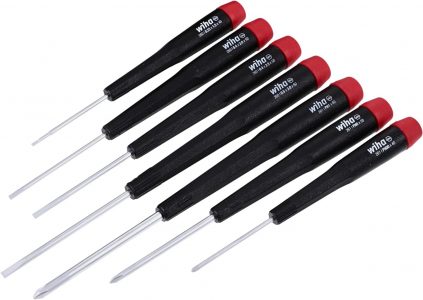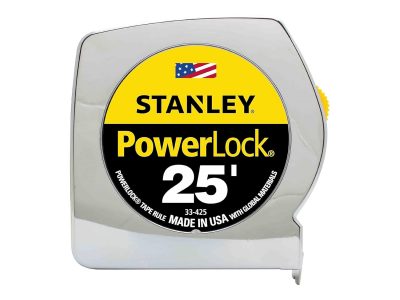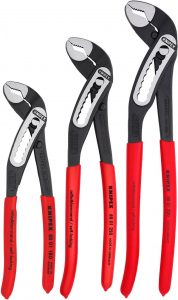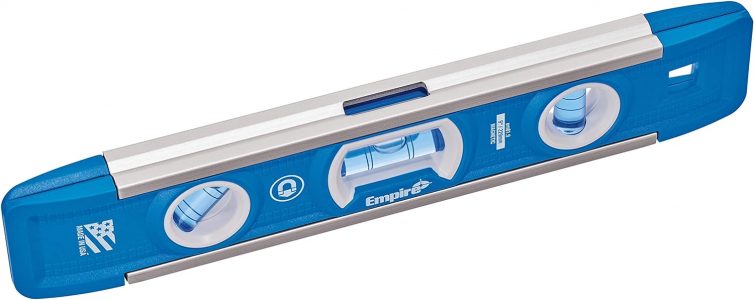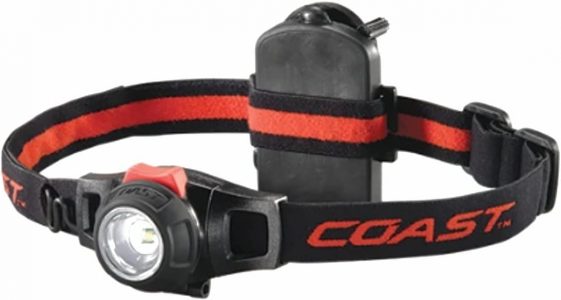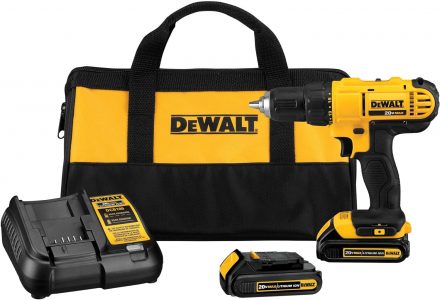🛠️ Best Tools for Quick Home Repairs
When it comes to maintaining a home, unexpected repairs are almost inevitable. From a leaky faucet in the kitchen to a loose doorknob or a picture frame that needs hanging, small issues can pop up at any time. While these tasks might seem minor, having the right tools on hand can make all the difference between a quick fix and a frustrating ordeal. Imagine trying to tighten a screw with the wrong size screwdriver or struggling to hang a picture that keeps tilting because you don’t have a level. The right tools not only make the job easier, but they also ensure that the repairs are done correctly, reducing the risk of further issues down the line.
Equipping yourself with a well-rounded set of basic tools empowers you to tackle a variety of common household tasks with confidence. Instead of delaying repairs or calling in a professional for every little thing, you can handle many problems on your own, saving both time and money. Moreover, having the right tools readily available can prevent small problems from escalating into bigger, more expensive ones. In this guide, we’ll walk you through the essential tools every homeowner should have, why they’re important, and how to use them effectively. Whether you’re new to DIY home repairs or looking to expand your toolkit, this article will provide you with the knowledge and confidence you need to keep your home in tip-top shape.
🔨 Basic Tools Every Homeowner Should Have
Building a solid foundation of basic tools is the first step toward becoming self-sufficient in handling common household repairs. Below, we’ll explore each essential tool in detail, explaining not just what it is, but why it’s necessary, how to choose the best version for your needs, and tips on how to use it effectively.
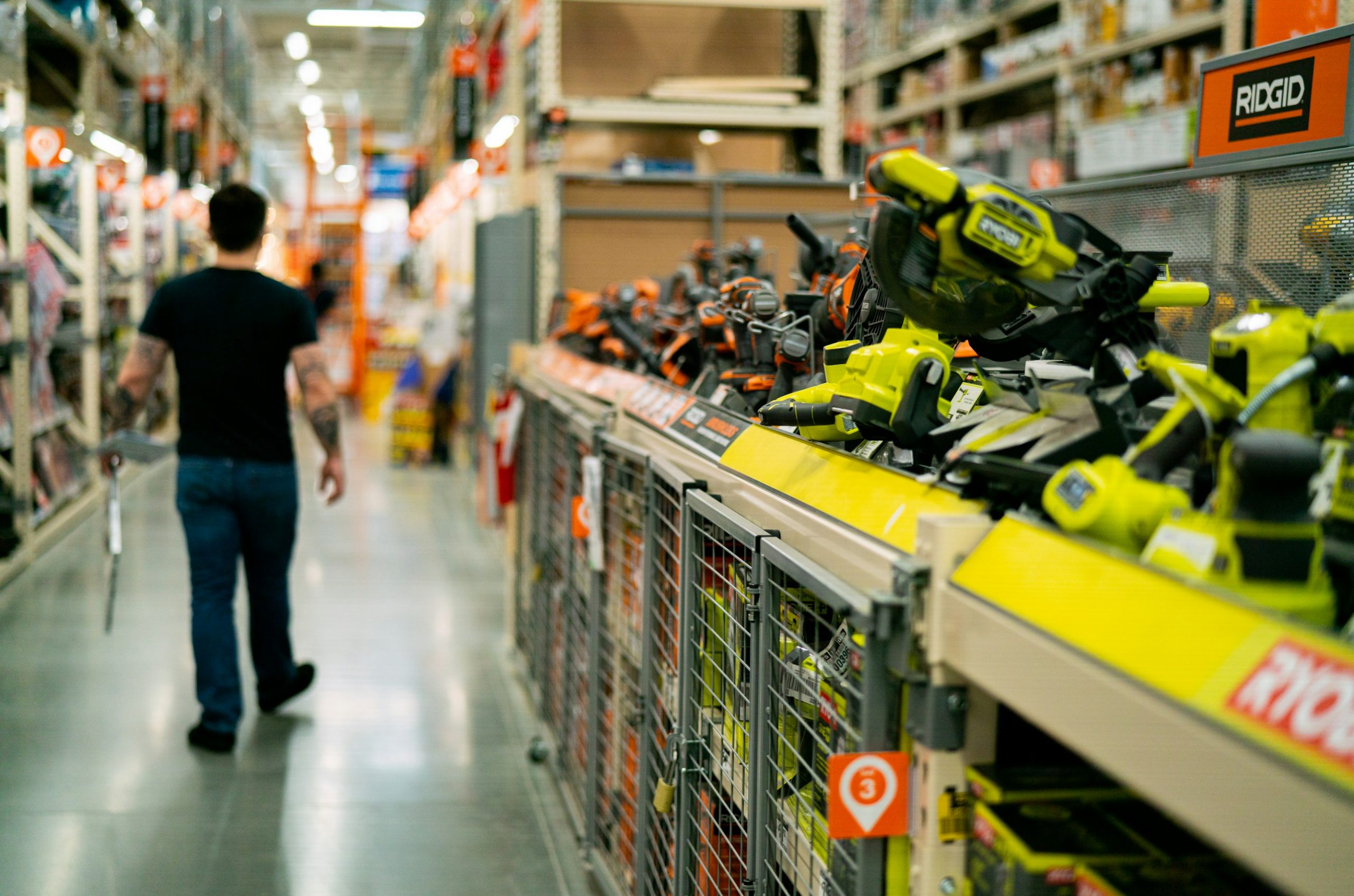
Hammer
A hammer is one of the most versatile tools in any toolkit, and it’s indispensable for a wide range of tasks. From driving nails into walls for picture hanging to small demolition projects, a hammer is often your go-to tool. When choosing a hammer, look for one with a comfortable grip that reduces hand fatigue, especially if you plan to use it for extended periods. A claw hammer, which features a curved, forked end opposite the head, is particularly useful as it can pull out nails as well as drive them in.
Pro tip: Practice your swing on a scrap piece of wood to gain better control and accuracy, especially if you’re new to using a hammer.
The Stanley FatMax Xtreme is a fantastic all-around hammer for both beginners and experienced DIYers. The 16-ounce weight strikes a perfect balance between power and control, making it versatile for various tasks. What sets this hammer apart is its AntiVibe technology, which reduces vibration and minimizes hand fatigue during extended use. The rip claw design also allows for easy nail removal.
Pros:
- Comfortable grip with AntiVibe technology
- Balanced weight for versatility
- Durable construction
Cons:
- Slightly more expensive than basic hammers, but worth the investment for regular use
Screwdrivers
Screwdrivers are essential for assembling furniture, tightening cabinet knobs, fixing loose screws, and more. You’ll encounter two main types: flathead (slotted) and Phillips (cross-shaped). It’s best to invest in a set that includes various sizes of both types, as screws come in different sizes and shapes. Magnetic screwdrivers are especially handy because they hold onto screws, making it easier to work in tight or awkward spaces. Pro tip: When dealing with old or stubborn screws, try placing a rubber band over the head of the screw before using the screwdriver. This can give you better grip and prevent slipping.
The Wiha 26197 is a precision screwdriver set that includes a variety of flathead and Phillips screwdrivers in different sizes. Each screwdriver features a soft-finish handle for a comfortable grip and superior torque. The set is perfect for tackling a range of tasks, from tightening screws on appliances to assembling furniture. The tips are hardened for durability, and the set comes in a compact case for easy storage.
Pros:
- High-quality, durable tips
- Comfortable ergonomic handles
- Includes a variety of sizes
Cons:
- More suitable for detailed work; may need a larger set for heavy-duty tasks
Tape Measure
Accurate measurements are crucial for tasks like hanging pictures at the right height, cutting materials to size, or ensuring furniture fits into a space. A 25-foot retractable tape measure is ideal for most household needs. Look for one with a lock mechanism, which allows you to hold the tape in place once you’ve extended it to the desired length. Pro tip: When measuring, start from a stable surface and pull the tape tight to avoid sagging, which can lead to inaccurate measurements.
The Stanley PowerLock Tape Measure is a classic choice that has stood the test of time. The 25-foot length is perfect for most household tasks, and the tape’s mylar-coated blade ensures durability. The PowerLock feature securely holds the tape in place while you measure, and the belt clip makes it easy to carry around during projects.
Pros:
- Durable and reliable
- Easy-to-read measurements
- Compact and portable
Cons:
- The locking mechanism can wear out with extensive use, though it lasts a long time under normal conditions
Pliers
Pliers are indispensable for gripping, bending, and cutting. Needle-nose pliers are great for precision tasks, such as bending wires or reaching into tight spaces, while standard pliers can handle tougher jobs like loosening bolts or pulling nails. Some pliers also come with wire-cutting capabilities, making them a multifunctional tool. Pro tip: When cutting wires, make sure to use the correct section of the pliers designed for cutting to avoid damaging the tool and ensure a clean cut.
The KNIPEX Alligator Pliers Set includes three sizes of pliers (7-inch, 10-inch, and 12-inch), making it incredibly versatile for various tasks. These pliers are known for their superior grip, thanks to the self-locking design on pipes and nuts. The set is also highly durable, with each tool made from high-grade, oil-hardened chrome vanadium steel.
Pros:
- Exceptional gripping power
- Versatile sizes included
- Extremely durable
Cons:
- More expensive than basic pliers, but the quality justifies the price
Adjustable Wrench
An adjustable wrench is a versatile tool that can tackle various sizes of nuts and bolts. Unlike fixed-size wrenches, an adjustable wrench can be modified to fit different fasteners, making it a must-have for plumbing tasks, assembling furniture, and more. Look for one with a smooth adjustment mechanism and a comfortable grip. Pro tip: Ensure the wrench is properly adjusted to the size of the fastener before applying force to prevent stripping or damaging the bolt or nut.
The Channellock WideAzz wrench is a standout in the adjustable wrench category. It offers a wider jaw capacity than typical adjustable wrenches, making it suitable for a broader range of fasteners. The ergonomic handle design ensures comfort during use, and the wrench is crafted from chrome vanadium steel for strength and durability.
Pros:
- Wide jaw capacity
- Comfortable handle design
- Durable construction
Cons:
- The larger jaw size may not fit into tight spaces as easily as smaller wrenches
Utility Knife
A utility knife is essential for cutting a variety of materials, such as cardboard, drywall, carpet, and more. Opt for a utility knife with a retractable blade for safety and one that offers easy blade changes. Pro tip: Always cut away from your body and keep your other hand clear of the cutting path to avoid accidents. Additionally, change the blade regularly to ensure clean cuts, as dull blades can slip and cause injuries.
The OLFA LA-X Snap-Off Utility Knife is a robust, versatile cutting tool that’s perfect for home repairs. The snap-off blades allow for quick and easy sharpening, ensuring you always have a sharp edge. The knife features a rubber grip handle for comfort and control, and the blade is securely locked in place during use.
Pros:
- Easy blade change with snap-off design
- Comfortable, non-slip grip
- Durable and sharp
Cons:
- Requires regular blade snapping to maintain sharpness
Level
Keeping your work straight and aligned is crucial, especially for tasks like hanging shelves or pictures. A small, 9-inch level is sufficient for most household tasks and easy to store. Look for one with easy-to-read bubbles and durable construction.
Pro tip: When leveling a long shelf or piece of furniture, use a longer level or a straight piece of wood alongside your shorter level to ensure accuracy across the entire length.
The Empire Torpedo Level is compact, easy to use, and highly accurate. The 9-inch size makes it perfect for smaller tasks around the home, like hanging pictures or leveling shelves. It features a magnetic edge, which is especially handy when working with metal surfaces. The vials are easy to read and offer high precision.
Pros:
- Compact and portable
- Magnetic edge for hands-free use
- High precision and easy-to-read vials
Cons:
- Limited to smaller projects due to its size
Flashlight or Headlamp
Good lighting is essential for working in dark or confined spaces, such as under sinks or in attics. A high-quality flashlight with a strong beam can illuminate your work area, but a headlamp is even better as it frees up both hands to work.
Pro tip: Choose a flashlight or headlamp with multiple brightness settings and a long battery life. Keep spare batteries on hand, especially for tasks that may take longer than anticipated.
The Coast HL7 Headlamp offers powerful illumination with an adjustable beam, allowing you to focus the light exactly where you need it. It’s comfortable to wear for extended periods and has a long battery life, making it perfect for working in dark or tight spaces. The adjustable headband ensures a secure fit, and the headlamp is durable enough to withstand tough conditions.
Pros:
- Adjustable beam for precise lighting
- Long battery life
- Comfortable and secure fit
Cons:
- Batteries need to be replaced regularly, though the long life helps mitigate this
Drill and Drill Bits
A cordless drill is one of the most versatile power tools you can own. It’s perfect for drilling holes and driving screws into a variety of materials, from wood to metal to masonry. Invest in a drill with variable speed settings and a good selection of drill bits for different tasks.
Pro tip: Always start drilling at a low speed to avoid slipping, especially on smooth surfaces. Gradually increase the speed as the bit gains traction.
The DEWALT 20V MAX Cordless Drill is a powerhouse tool, perfect for a variety of household tasks. It features a high-performance motor and two-speed settings, making it versatile for drilling holes and driving screws. The compact and lightweight design reduces user fatigue, and the kit includes two batteries, ensuring you always have power when you need it.
Pros:
- Powerful and versatile
- Long battery life with two batteries included
- Lightweight and easy to handle
Cons:
- Slightly higher price point, but excellent value for a reliable, durable tool
🧰 Additional Handy Tools
While the basic tools we’ve covered are essential for most home repairs, having a few additional tools on hand can make certain tasks easier and allow you to tackle a wider variety of projects. These tools might not be used as frequently as your hammer or screwdriver, but when the need arises, you’ll be glad you have them. Below, we’ll explore these handy tools in detail, explaining their uses, how to choose the right ones, and tips on maximizing their effectiveness.
Allen Wrenches (Hex Keys)
- What They Are: Allen wrenches, also known as hex keys, are L-shaped tools used to drive bolts and screws with hexagonal sockets in their heads. They are commonly used in furniture assembly, particularly with flat-pack furniture, as well as in bicycles, appliances, and automotive work.
- Why You Need Them: Allen wrenches are essential for any task involving hex screws, which are increasingly common in modern furniture and fixtures. Having a set of these tools allows you to assemble and disassemble items without damaging the screws, ensuring that everything is properly secured.
- How to Choose: Allen wrench sets typically come in both metric and imperial sizes. For most household tasks, a set that includes both types will cover all your needs. Consider a set with a ball end, which allows you to work at an angle in tight spaces, offering more flexibility.
- Pro Tip: Keep your Allen wrenches organized by size to avoid wasting time searching for the correct one. Some sets come with a holder or case that keeps them in order.
TEKTON Long Arm Ball End Hex Key Wrench Set
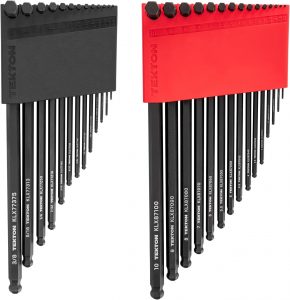
The TEKTON Long Arm Hex Key Wrench Set offers both metric and imperial sizes, making it versatile for a wide range of tasks. The ball end design allows you to work at angles up to 25 degrees, which is incredibly useful in tight spaces. The long arm gives you better reach and leverage, and the tools are made from heat-treated steel for durability.
Pros:
- Comprehensive set with both metric and imperial sizes
- Ball end for angled access
- Durable, heat-treated steel
Cons:
- The case could be more compact for easier storage, but it effectively organizes the tools
Caulking Gun
- What It Is: A caulking gun is a tool used to apply caulk, a material that seals joints or seams in various structures and piping. It’s commonly used around windows, bathtubs, sinks, and other areas where water or air leaks might occur.
- Why You Need It: Caulking is a simple yet effective way to prevent leaks and drafts, which can lead to energy loss or water damage if left unchecked. A caulking gun allows you to apply caulk smoothly and evenly, ensuring a professional finish.
- How to Choose: Look for a caulking gun with a smooth trigger mechanism and an easy-to-use release lever. Manual caulking guns are suitable for most home use, but if you have a large project, you might consider a battery-powered model for ease of use.
- Pro Tip: Before applying caulk, make sure the area is clean and dry to ensure the best adhesion. Apply the caulk in a continuous motion, and use a damp finger or a caulk-smoothing tool to achieve a clean, professional-looking finish.
Newborn 930-GTD Drip-Free Smooth Hex Rod Cradle Caulking Gun
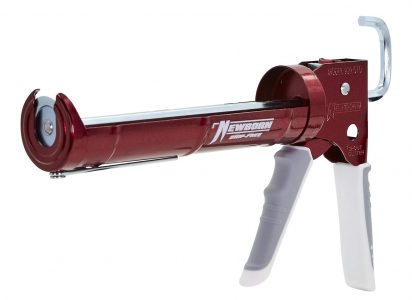
The Newborn 930-GTD is a professional-grade caulking gun that’s incredibly user-friendly. It features a smooth pressure rod that requires less force and provides a consistent flow of caulk. The drip-free mechanism prevents excess caulk from oozing out, ensuring a cleaner application. The handle is ergonomically designed, reducing hand fatigue during extended use.
Pros:
- Drip-free mechanism for clean application
- Smooth pressure rod for easy use
- Ergonomic handle for comfort
Cons:
- Slightly heavier than basic caulking guns, but the build quality justifies the weight
Putty Knife
- What It Is: A putty knife is a flat-bladed tool used for applying and smoothing materials like spackle or putty. It’s also useful for scraping off old paint, wallpaper, or caulk.
- Why You Need It: Whether you’re filling nail holes in the wall, repairing cracks, or scraping away old materials, a putty knife is a versatile tool that’s essential for achieving smooth, even surfaces.
- How to Choose: Putty knives come in various widths, typically ranging from 1 to 6 inches. A 2-inch flexible blade is ideal for most patching jobs, while a wider, stiffer blade is better for scraping tasks. Stainless steel blades resist rust and are more durable than cheaper alternatives.
- Pro Tip: After using your putty knife, clean it immediately to prevent material from hardening on the blade. This will prolong the life of your tool and keep it ready for the next job.
Warner ProGrip 2-Inch Flex Putty Knife

The Warner ProGrip 2-Inch Flex Putty Knife is an excellent choice for applying and smoothing putty or spackle. Its flexible blade allows for a smooth finish, while the ergonomic handle provides a comfortable grip. The full tang blade construction ensures durability, and the stainless steel blade resists rust and corrosion, making it a long-lasting tool in your kit.
Pros:
- Flexible blade for a smooth application
- Ergonomic handle for comfort and control
- Durable, rust-resistant stainless steel
Cons:
- Limited to smaller jobs due to the 2-inch blade size, but it’s perfect for detailed work
Safety Gear
- What It Is: Safety gear includes items like safety goggles, work gloves, dust masks, and ear protection. These are crucial for protecting yourself while performing potentially hazardous tasks.
- Why You Need It: Safety should always be a top priority when doing any kind of repair work. Whether you’re cutting, drilling, or working with chemicals, wearing the appropriate safety gear can prevent injuries and long-term health issues.
How to Choose:
- Safety Goggles: Look for goggles that offer a snug fit around your eyes and are impact-resistant. Anti-fog lenses are a plus if you’re working in humid conditions.
- Work Gloves: Choose gloves made from durable material that provides a good grip without sacrificing dexterity. Leather or cut-resistant gloves are ideal for handling sharp objects.
- Dust Masks: For tasks involving dust, mold, or fumes, a good dust mask or respirator is essential. Make sure it fits securely and has a filtration rating appropriate for the task at hand.
- Ear Protection: If you’re using loud power tools, invest in earplugs or earmuffs to protect your hearing.
Pro Tip: Store your safety gear in an easily accessible location near your tools, so you’re always reminded to use it before starting a project.
3M WorkTunes Connect Hearing Protector with Bluetooth Technology
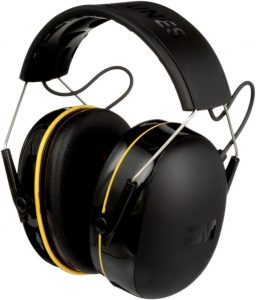
The 3M WorkTunes Connect Hearing Protector not only provides excellent ear protection with an NRR (Noise Reduction Rating) of 24 dB but also includes Bluetooth technology, allowing you to listen to music or take calls while working. The low-profile design and comfortable ear cushions make it easy to wear for extended periods. It’s an excellent all-in-one solution for those who need ear protection and enjoy having audio while working.
Pros:
- Effective noise reduction with 24 dB NRR
- Bluetooth connectivity for audio and calls
- Comfortable and durable design
Cons:
- Requires regular charging for Bluetooth use, but battery life is good
Toolbox or Tool Bag
- What It Is: A toolbox or tool bag is essential for organizing and storing your tools. It keeps everything in one place, making it easier to find what you need when you need it.
- Why You Need It: Keeping your tools organized not only saves time but also prolongs their life by protecting them from damage. A good toolbox or tool bag ensures that you always know where your tools are, preventing unnecessary frustration.
How to Choose:
- Toolbox: If you prefer a hard case, look for a toolbox with multiple compartments and trays to separate small items like screws and nails from larger tools. A sturdy handle and durable latches are important for long-term use.
- Tool Bag: For more portability, a tool bag with multiple pockets and a reinforced bottom is a great choice. Choose one with padded straps for comfort, especially if you plan to carry it around frequently.
Pro Tip: Regularly go through your toolbox or tool bag to clean out any debris, remove duplicate items, and make sure everything is in working order. This practice will help you stay organized and ensure your tools are always ready for use.
DEWALT DWST08204 ToughSystem Toolbox
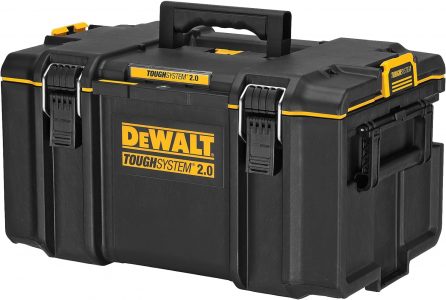
The DEWALT ToughSystem Toolbox is a heavy-duty, stackable toolbox that’s perfect for keeping your tools organized and protected. It’s water-resistant and built to withstand tough conditions, making it ideal for both home use and more demanding environments. The internal tray allows for easy organization of smaller items, while the large main compartment can hold bigger tools.
Pros:
- Extremely durable and water-resistant
- Stackable and compatible with other ToughSystem components
- Spacious with an internal tray for organization
Cons:
- Bulkier than some toolboxes, but offers superior protection and durability
🛒 Tips for Buying Tools: A Comprehensive Guide
When it comes to purchasing tools for home repairs, making informed decisions is crucial. The right tools can make your DIY projects easier, faster, and more enjoyable, while the wrong ones can lead to frustration, wasted money, and even potential injury. Whether you’re building your first toolkit or looking to upgrade your existing collection, here are some essential tips to help you make the best choices.
Quality Over Quantity
Investing in a few high-quality tools is far better than buying a large set of cheap, low-quality tools. High-quality tools are more durable, perform better, and are often safer to use. While they may cost more upfront, they usually last much longer, providing better value over time.
How to Spot Quality:
- Material: Look for tools made from durable materials such as chrome vanadium steel for wrenches and pliers, and high-carbon steel for cutting tools. These materials are strong, resistant to corrosion, and hold up well under pressure.
- Brand Reputation: Established brands like DEWALT, Stanley, KNIPEX, and Milwaukee are known for producing reliable, high-quality tools. Research brand reputation and read reviews before making a purchase.
- Build Quality: Pay attention to the construction of the tool. High-quality tools often have solid, ergonomic handles, secure fastenings, and precision-machined parts.
Pro Tip: Start with essential tools and gradually expand your collection as needed. This approach allows you to invest in quality without overwhelming your budget.
Read Reviews and Do Your Research
Reviews from other customers can provide valuable insights into the performance and reliability of tools. They can alert you to potential issues, highlight the pros and cons, and help you make an informed decision.
What to Look For:
- Product Ratings: Check the overall rating but also read through both positive and negative reviews to get a balanced view.
- Detailed Feedback: Look for reviews that offer detailed feedback on how the tool performs in real-world situations. These can be more informative than brief comments like “good tool” or “didn’t work.”
- Comparison Articles: Consider reading comparison articles or buying guides that evaluate similar products. These can help you understand how a particular tool stacks up against the competition.
- Pro Tip: Be wary of overly glowing reviews that seem generic or too good to be true. Look for reviews that address specific features and use cases.
Consider Your Specific Needs
Your choice of tools should align with the types of repairs and projects you’re most likely to undertake. Buying tools that are well-suited to your needs will ensure they get regular use and don’t just sit unused in your toolbox.
How to Assess Your Needs:
- Frequency of Use: For tools that you’ll use frequently, such as a drill or screwdriver, it’s worth investing in higher-quality options. For tools that you might only use occasionally, like a stud finder or a caulking gun, you might opt for a more budget-friendly option.
- Project Types: Think about the projects you plan to tackle. If you’re mostly doing basic repairs, you’ll need different tools than if you’re planning on more complex DIY projects, such as woodworking or plumbing.
- Space and Storage: Consider the amount of storage space you have available. If you’re limited on space, look for tools that are compact or multifunctional, reducing the need for multiple, single-purpose tools.
- Pro Tip: Make a list of the tools you currently own and the projects you’ve completed recently. This will help you identify any gaps in your toolkit and ensure you’re buying tools that will actually be useful.
Test Tools When Possible
If you have the opportunity, it’s always a good idea to physically handle a tool before buying it. This allows you to assess its weight, grip, and overall feel, which are important factors in how comfortable and effective the tool will be during use.
Where to Test:
- In-Store Shopping: Many hardware stores have display models of tools that you can handle. Pay attention to how the tool feels in your hand, whether the grip is comfortable, and if the tool feels well-balanced.
- Tool Rentals: If you’re unsure about a particular tool, consider renting it first. This gives you a chance to test it out on a project before committing to a purchase.
- Pro Tip: Even if you prefer to shop online for convenience or better prices, testing tools in-store first can help you make a more informed decision.
Think About Ergonomics and Comfort
Tools that are comfortable to use are more enjoyable to work with and reduce the risk of fatigue or injury. Ergonomically designed tools are especially important if you plan to use them for extended periods.
What to Look For:
- Grip: Look for tools with soft, non-slip handles that fit comfortably in your hand. The grip should be secure without requiring excessive pressure to hold.
- Weight: Consider the weight of the tool. While heavier tools can sometimes offer more stability, they can also cause hand and arm fatigue if used for long periods. Balance is key.
- Ease of Use: Features like adjustable settings, quick-release mechanisms, and smooth operation all contribute to making a tool easier and more pleasant to use.
- Pro Tip: If you have smaller hands or limited hand strength, pay extra attention to the size and weight of the tools you choose. Compact or lightweight versions of tools might be more comfortable and effective for you.
Plan for Storage and Organization
Proper storage not only keeps your tools organized and easy to find but also protects them from damage, ensuring they last longer. Having a good storage system can also save you time, as you won’t have to search for the tool you need.
How to Organize:
- Toolbox or Tool Bag: Invest in a quality toolbox or tool bag that fits your needs. For large collections, consider a tool chest with drawers or a wall-mounted pegboard for easy access.
- Modular Storage: If you have a growing collection, consider modular storage solutions that can expand as your toolkit does. Stackable toolboxes, for example, allow you to customize your storage as needed.
- Labeling: Label drawers, bins, or tool slots to quickly identify where each tool belongs. This helps keep everything in its place and reduces clutter.
- Pro Tip: Regularly clean and maintain your tools before storing them. Wipe off any dirt, debris, or moisture to prevent rust and wear, and check for any damage that might need repair.
Buying tools is an investment in your ability to maintain and improve your home. By focusing on quality, doing thorough research, and considering your specific needs, you can build a toolkit that will serve you well for years to come. Whether you’re a novice DIYer or an experienced handyman, these tips will help you make smart, informed decisions, ensuring that you get the best value for your money and tools that you’ll enjoy using.
🔍 Frequently Asked Questions (FAQ)
What are the absolute must-have tools for home repairs?
At a minimum, every homeowner should have a hammer, screwdrivers (both flathead and Phillips), a tape measure, pliers, an adjustable wrench, a utility knife, a level, a flashlight, and a cordless drill. These tools cover the basics for most common home repairs.
How much should I expect to spend on a good set of tools?
The cost can vary depending on the brand and quality, but for a basic set of quality tools, you should expect to spend around $100 to $200. For more comprehensive kits that include additional handy tools, the cost could range from $200 to $500.
Should I buy tools individually or in a set?
It depends on your needs. If you’re just starting out, a tool set can be a cost-effective way to get multiple essential tools at once. However, if you already have some tools, or you need specialized tools, buying individually allows you to choose higher-quality items tailored to your needs.
What should I look for in a quality tool?
Focus on the materials, build quality, brand reputation, and ergonomics. High-quality tools are often made from durable materials like chrome vanadium steel and have features like comfortable grips, precision machining, and reliable mechanisms.
How can I tell if a tool is good quality before I buy it?
Read reviews, research the brand, and if possible, test the tool in-store to assess its feel and build quality. Look for details like smooth operation, secure fastenings, and solid construction. Trusted brands often provide reliable quality, but customer reviews can offer additional insights.
Are power tools necessary for home repairs?
While many basic repairs can be done with manual tools, certain tasks are much easier with power tools. A cordless drill is particularly useful for driving screws and drilling holes. Other power tools, like a jigsaw or circular saw, are great for more advanced DIY projects but aren’t necessary for basic repairs.
What’s the best way to organize and store my tools?
Use a sturdy toolbox or tool bag for portability. For larger collections, consider a tool chest with drawers or a wall-mounted pegboard. Keep your tools organized by type, and label storage areas to make finding the right tool easier. Regular maintenance and cleaning before storage will help prolong the life of your tools.
How often should I replace my tools?
Quality tools can last for many years with proper care, but you should replace any tools that show signs of wear and tear, like rust, dull blades, or cracked handles. Regularly inspect your tools and replace them as needed to ensure they function safely and effectively.
What should I do if I don’t know how to use a tool?
There are many resources available, including online tutorials, YouTube videos, and DIY blogs, that can teach you how to use various tools. Start with small projects to build your confidence and skills. You can also ask for help from more experienced friends or family members.
How do I know if I need a specialized tool for a job?
Consider the specific requirements of your project. If a task involves materials or situations that standard tools can’t handle—like cutting intricate shapes, working with electrical wiring, or plumbing—you may need specialized tools. Research your project ahead of time to determine what’s required.


